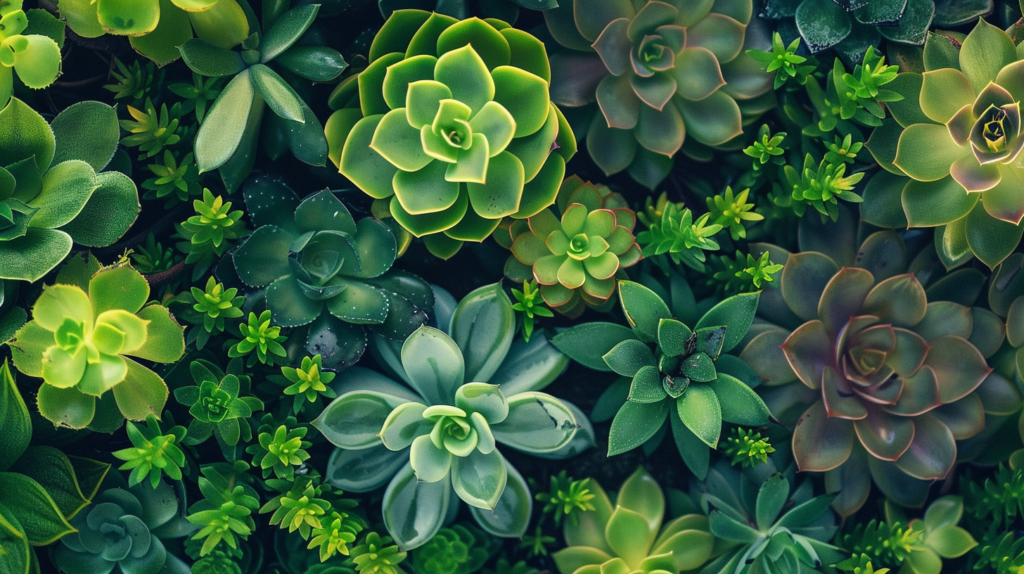plants positive effects
Plants don’t just decorate and color our interiors; they also play a crucial role in our well-being. Scientific studies have shown that the presence of plants in our immediate environment has significant positive effects on our physical and mental health, contributing to our happiness.
Air Purification
Plants help improve indoor air quality. Through the process of photosynthesis, they absorb carbon dioxide and release oxygen, promoting a healthier environment. Some plant species also have the ability to filter and neutralize airborne toxins such as benzene, formaldehyde and trichloroethylene, substances often associated with building materials, paints and furniture.
Stress Reduction and Mood Improvement
The presence of plants in living and working spaces has been associated with reduced stress and improved mood. Observing nature and tending plants can induce a meditative state, reducing anxiety and promoting a sense of calm and well-being. What’s more, green spaces stimulate creativity and boost productivity.
Improved concentration and productivity
Research has shown that working or studying in an environment with natural elements, such as plants, can significantly improve concentration, satisfaction and productivity. The color green has a calming effect that can help reduce eye fatigue and increase concentration.
Physical Health Benefits
The presence of plants can also have direct beneficial effects on physical health. They can help reduce air dryness by increasing humidity through transpiration, which is particularly beneficial during winter months or in air-conditioned environments. This can help prevent conditions such as dry skin, sore throats and irritated eyes.
Feng Shui effects
According to the art of Feng Shui, plants play an essential role in creating a harmonious, balanced space. They symbolize life, growth and prosperity. Positioning plants in specific areas of the home can help attract positive energies and balance the five elements of Feng Shui, improving overall well-being.
Tips for Integrating More Plants into Your Life

- Choose plants that suit your space and lifestyle: some require more light or maintenance than others.
- Consider purifying air and easy-care plants like pothos, dracaena, or areca for starters.
- Create a green corner in your home where you can relax and recharge.
“Have you also developed a good relationship with your plants as a result of working from home? Then reward them with some good music. Research has shown that sound vibrations stimulate plant growth. Type ‘music for plants’ into the search bar of your music platform and you’ll find the playlist.”
Working from home has given many of us the opportunity to observe up close and enjoy the company of our houseplants. This increased cohabitation can encourage us to care for them in a more attentive and original way. The idea of “music for plants” is rooted in studies suggesting that plants respond favorably to sound stimuli, particularly music.
- Keep in mind the benefits of listening to music on plants: some studies suggest that music can promote plant growth.
By integrating more plants into our lives, we’re not only making an aesthetic choice, we’re also investing in our health and happiness.
The Scientific Basis

Experiments have shown that certain sound frequencies can affect the germination, growth and even flowering of plants. The vibrations produced by music can encourage cell movement in plants, facilitating more robust growth. This phenomenon is mainly due to the ability of plants to react to environmental vibrations to promote growth and survival.
How Music Affects Plants
- Growth Stimulation: Music with a gentle frequency and rhythm, such as classical or jazz, can stimulate plant growth more effectively than louder or more discordant musical genres.
- Photosynthesis enhancement: Sound and vibration can encourage the movement of stomata (small openings on plant leaves), improving the photosynthesis process.
- Effect on Plant Health: Music can not only promote faster growth, but also boost plant resistance to disease and pests.
How to “Play” Music for Your Plants
- Choose the right music: opt for quiet, melodious tunes. Playlists dedicated to plants on platforms like Spotify are a great place to start.
- Moderate volume: Music that’s too loud could have the opposite effect and stress plants. A moderate volume is preferable.
- Daily routine: Incorporate music into your plant care routine. A little music every day can do wonders.
See for yourself
The effect of music on plants offers a fascinating field for personal experimentation. By observing the reactions of your own plants to different musical genres, you can not only enrich your indoor gardening experience but also create a more harmonious and dynamic environment at home.
This reaffirms the idea that plants are living beings sensitive to their environment, capable of reacting in surprising ways to the love and care we give them, including through music.
Botanical music, listen to the secret song
The idea that plants can produce music may sound like something out of a fairy tale, but thanks to technological advances and a deeper understanding of the plant world, this fascinating concept is becoming a tangible reality. When we speak of music through plants, we are referring to the use of electronic devices capable of translating electrical variations in plants into sound or music. This approach offers a new perspective on how we perceive and interact with the plant world, highlighting their sensitivity and responsiveness to the environment.
How does Plant Music work?
Plant music is based on bioelectricity. All living beings generate electrical activity as a result of the biological processes taking place in their cells. In plants, this activity can be influenced by many factors, such as light, humidity, temperature, and even the proximity of humans or other living beings. Specific devices, equipped with electrodes placed on the leaves and other parts of the plant, measure these variations in electrical potential.
These variations are then converted into sound signals using a synthesizer or specific software, creating what is known as “plant music”. The sounds produced can vary considerably, from gentle melodic sequences to more complex compositions, depending on the plant and environmental conditions.
Meaning and implications
The music produced by plants opens windows onto their inner world, offering unique insights into their secret lives. This unconventional interaction with plants can encourage a greater appreciation of their presence and ecological importance, as well as a new level of connection with nature.
- Education and awareness: Listening to the music produced by plants can raise awareness of the importance of caring for our environment and promote a more empathetic approach to the plant world.
- Wellness and therapy: Plant music can have therapeutic effects, helping to reduce stress and promote relaxation. The unique experience of hearing the “voices” of plants can contribute to a sense of peace and connection with nature.
- Art and Performance: Artists and musicians use plant music as a source of inspiration or as a central element in performances and art installations, exploring new forms of expression and collaboration with the plant world.
Personal experimentation
For those interested in exploring plant music at home, there are expensive kits and devices available for purchase that turn the electrical activity of your plants into music. But you can also experiment with our MEDITASOUND application, packed with minimalist music composed using plants on our unique modular synthesizer.
It’s a fascinating way to engage in a dialogue with your plants and discover how responsive they are to the care and attention you give them.
Music through plants reminds us that plants are much more than mere decorations or sources of oxygen; they are dynamic living entities, capable of communicating with us in unexpected and deeply moving ways.
Plant Music as a Meditation Tool
Meditation is recognized for its many benefits, including stress reduction, improved concentration and the promotion of a general state of well-being. However, many people find it difficult to meditate effectively, partly due to an inability to calm their mind or maintain concentration. The use of Plant Music could offer an attractive alternative or complement to traditional meditation methods.
It has recently been shown that listening to Plant Music for half an hour has the same effect on the brain as two hours of meditation. The study group was still too small to be totally certain, but the results point in this direction. What’s more, based on our users’ experience, they achieve a different state of consciousness.”
This discovery offers an intriguing perspective on the potential of interactions between humans and the plant world, particularly with regard to our mental and emotional well-being. Although the research is in its early stages and requires larger samples for definitive conclusions, the implications are promising for the development of innovative wellness practices.
Harmony with nature
This innovative approach to interaction with the natural world highlights the importance of the invisible connections that bind all living things together. Using technology to translate the biological activity of plants into music or soundscapes allows us to perceive these links in a tangible and emotional way, reinforcing our understanding of nature’s complexity and interdependence. It invites us to reflect on our place in the global ecosystem, and on the ways in which we can coexist more harmoniously with our environment.
Enthusiasts use advanced technology to connect with nature. Some use biofeedback techniques to transform the biological activity of plants into melodious soundscapes. The aim of this approach is to make us aware of our intrinsic and symbiotic link with the natural environment. The sounds produced not only reveal the inner life of an isolated plant, but also highlight the interconnection between plants, and their close relationship with human beings.
Effects on the Brain
Listening to Plant Music can induce a state of deep relaxation and meditation by facilitating the brain’s shift to alpha and theta wave frequencies, associated with deep relaxation and meditation. These brain states help reduce stress, improve mood, and can even stimulate creativity and intuitive thinking.
User experiences
Users who have experienced listening to the Music of Plants often report a feeling of inner peace and an altered state of consciousness, similar to that achieved by deep meditation. Some describe a deeper connection with nature or a heightened awareness of the natural environment around them.
Future prospects
If future research confirms the preliminary results, Plant Music could become a valuable tool in the field of mental well-being and meditation. Therapists, wellness centers and individuals seeking to enhance their meditation practice could integrate Plant Music as a means of accessing deeper states of relaxation and awareness.
Meanwhile, exploring the Music of Plants offers a unique opportunity to connect with the plant world in a way that promotes peace of mind and emotional well-being. It’s a fascinating field that broadens our understanding of nature’s healing capacities and our interaction with it.
Technological Harmony: Reconnecting with Nature in the Modern Era
By exploring the deep and often invisible ties that bind humankind to nature, modern technology offers us a unique window onto the complexity of these relationships. By transforming the biological activity of plants into music, we not only experience their world in new and innovative ways, but are also invited to reflect on our interdependence with the natural environment. This awareness can inspire us to adopt more sustainable, nature-friendly behaviors, strengthening our connection with the world around us. Ultimately, these initiatives underline the importance of living in harmony with our planet, reminding us that every form of life, no matter how small, plays an essential role in the balance of our ecosystem.

